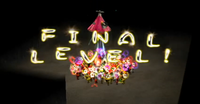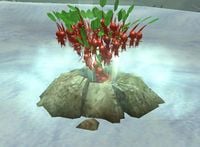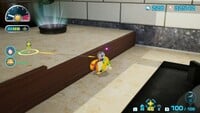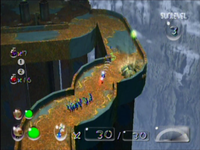Cave
Caves (洞窟?, lit.: "Cave") are underground locations in Pikmin 2 and Pikmin 4. Exploring them is important since they contain treasures, castaways, Flarlic, and wild Pikmin inside. Each cave consists of a series of cramped sublevels that limit the player's possibilities, with the gameplay and ambiance inside reflecting that fact:
- There are usually only one or two possible paths the player can follow to explore a given sublevel.
- Since there is no access to Onions, it is impossible to retrieve more Pikmin, and getting new Pikmin can only be done with Candypop Buds, Bulbmin, or wild Pikmin.
- The current day cannot be ended until the cave is exited.
- The music in caves is significantly more minimal than the music in outside areas, and in Pikmin 2 is partially randomly generated following specific parameters, like the terrain.
Caves in both games are composed differently, with sublevels in Pikmin 2 being generated randomly each time, but following a specific layout scheme, while sublevels in Pikmin 4 are fixed and focus more on puzzle-solving. The two games also have other minute differences in the way caves work.
Caves are entered through holes in the areas. Similarly, somewhere in the cave is a way to exit it, allowing the player to safely return to the surface with all of their collected objects.
In Pikmin 2, stages in Challenge Mode and 2-Player Battle also take place in caves, but this article focuses on the caves in Story Mode, which includes Dandori Challenge and Dandori Battle stages. The other Pikmin games do not have caves per se, but have underground locations regardless. Pikmin has The Forest Navel, Pikmin 3 has underground sections within its main areas, and Hey! Pikmin has some cave-themed levels.
List of caves[edit]
Pikmin 2[edit]
Pikmin 4[edit]
Dandori caves[edit]
Sublevel[edit]
Each cave is divided into a number of sublevels. Each sublevel consists of a small isolated location, and will usually have at least one treasure or castaway and a few enemies. The player can only play on one sublevel at a time, and there can't be any Pikmin activity outside the current sublevel or cave. The shortest cave in Pikmin 2 – Emergence Cave – has two sublevels and the longest – Hole of Heroes – has fifteen.
When a cave is entered, the player will land in its first sublevel, and will be able to proceed through that cave's sublevels in order through the use of holes. Some sublevels have a way to exit safely while keeping all collected objects.
Every time a sublevel is entered the game is saved, so if the player turns the game off and then back on again, they will start in the same sublevel. In the case of Pikmin 2, the sublevel will be generated randomly again.
Sublevels in Pikmin 2 can generally be categorized into 3 types, those being:
- Normal levels usually have a few harmful enemies, and sometimes don't have any treasure.
- Rest levels either lack enemies or only have harmless enemies (exceptions being Doodlebugs and Bulbmin). Rest levels have Pikmin-supporting items, such as nectar, ultra-bitter spray, ultra-spicy spray, or Candypop Buds. These levels usually lack treasures, and feature special ambient music. Most rest levels also have a geyser available, so the player can return to the surface if they have a low number of Pikmin.
- Boss levels contain one or more large bosses, are usually the final level of a cave. The only cave without a boss level is the Emergence Cave, and the one with the most is the Hole of Heroes. When the boss is defeated, it often drops an upgrade for the leaders' space suits or ship.
Pikmin 4 has a greater emphasis on puzzles and exploration, with all sublevels having fixed layouts, compared to Pikmin 2's random generation on most of its sublevels. Some sections of some layouts are references to or outright reworkings of cave units originally from Pikmin 2, such as room_hitode4x4_3_metal and room_dan4x4i_3_conc.
Final floor[edit]

Since at the final sublevel of a cave there is nowhere else to go, all final floors contain a geyser or air vent for the player to return to the surface and end their cave mission.
Typically, final sublevels have something grand to them. In Pikmin 2, the final floor of all caves except the Emergence Cave is a boss level, and in Pikmin 4, most caves have a castaway to rescue at the final sublevel.
In Pikmin 2, the deepest sublevel of every cave receives special attention by the game and is known as the final floor, or the final level in the European New Play Control! version. As the player drops into it, the game announces this by playing a distinct jingle, along with displaying the words "FINAL FLOOR!" or "FINAL LEVEL!" in large, yellow letters, before the player regains control. Additionally, on the HUD, the word "SUBLEVEL" in the top-right corner is replaced with the words "FINAL FLOOR" or "FINAL LEVEL" in yellow.
In Pikmin 4, there is far less attention drawn, simply displaying "FINAL SUBLEVEL" in place of the number as it fades away. For caves with only 1 sublevel (Burrow of Beginnings, Last-Frost Cavern, Dream Home, Sightless Passage), the distinction does not appear at all.
Hole[edit]
To enter a cave, the player must get close to a hole and press the throw button. To go from one sublevel to the next, the same must be done to a similar hole within the sublevel.
In Pikmin 2, the holes are round, rocky mounds, with a small hole in them. On the cave entrance hole, if the cave has not been completed, wisps of steam will come out, and the screen will become foggy when the hole is approached. In contrast, if it has been completed, a simple red flag will be placed near the entrance. Inside a cave, the hole to a next sublevel will always contain steam, but will not fog the screen.
In Pikmin 4, the holes are black tubes with colored lids – cyan for normal caves, gray for Dandori Challenges, and orange for Dandori Battles. They are actually Japanese curb boxes, which are plastic tubes that house valves. After completing that cave, a flag appears in the color of the player's spacesuit with the Rescue Corps logo. When completing Burrow of Beginnings for the first time, Collin can be seen placing one such flag down in a cutscene. In addition, some caves have 2 holes, where the player will enter in one side and exit on the other such as the Aquiferous Summit , the Frozen Inferno and the Engulfed Castle. Entering the "Exit" side of the cave (which has no cyan lid) from the surface will slightly change the layout to allow the sublevels to be cleared in reverse order, with an air vent that takes the player back to the "entrance" hole on the first sublevel. Exiting a cave from the pause menu will take the player back to the hole they entered from.
Mechanics[edit]
Passage of time[edit]
In Pikmin 2, the time of day does not pass while the player is in a cave. According to earlier versions of the game, this is because the space-time continuum was warped due to the cave's geomagnetic radiation field.[1] The final version's instruction manual simplifies this and simply calls it "a powerful magnetic field".[2][3]
In Pikmin 4, time does pass while underground, but only at a sixth of its normal speed. If the overworld time reaches the sunset countdown while the player is exploring a cave, nothing will happen and the player will be free to continue inside the cave for as long as they want, but as soon as they leave the cave the sunset countdown will begin. Caves also cannot be entered during the sunset countdown.
Object spawning[edit]
Some objects respawn between visits to the same cave, including enemies. The rules are as follows:
| Object | Respawns | |
|---|---|---|
| Pikmin 2 | Pikmin 4 | |
| Treasures | Never | Never |
| Enemies | Always | If cave is 100% complete |
| Obstacles | Always | Never |
Treasures will not reappear once collected, unless the way the player exits the cave puts them back (escape with the Hocotate ship in Pikmin 2 or failure). Some Candypop Buds that have a maximum Pikmin requirement will also not show up.
In Pikmin 4, wild Pikmin, enemy corpses, treasures, and so on will remain in the same state the player left the cave in for a few days, position included, until the cave is completed, at which point the standard rules for respawning everything from scratch described above apply. Candypop Buds can also respawn between visits even if the cave has not been completed.
Entering caves[edit]
Once the player chooses to enter a cave from a hole, a confirmation menu appears with some information about the cave. In Pikmin 2, it shows the kinds of hazards inside, and in Pikmin 4, the first page lets the player pick a sublevel to land on from previously visited sublevels, and the second page shows the Onion menu so the player can pick which Pikmin join them inside.
If the player accepts, the current leader, the other leader or Oatchi, and the squad of Pikmin will all jump inside in a brief cutscene. For Dandori Challenge and Dandori Battle caves, the Pikmin will refuse to go inside, however. The other leader or Oatchi will join in regardless of distance, and in Pikmin 4, the player's character and Oatchi will also join in even if they are knocked out, despite the entering cutscene not showing it.
When entering a cave, any Pikmin that do not go in will be safely returned to their Onions. In Pikmin 2, Pikmin in an idle leader's group will not be a part of the Pikmin that go in, even if the idle leader enters.
Any leader and Oatchi will regain full health when entering a cave. In Pikmin 2, it is impossible to explore a cave without Pikmin, and while it is possible in Pikmin 4, the game shows a confirmation dialog stating that it's hard to explore without any.
Some cave entrances have a hazard surrounding them, and require the player to be able to combat that to get in. The Submerged Castle in Pikmin 2 and the Engulfed Castle in Pikmin 4 can only be entered with Blue Pikmin due to the entrance being underwater. The Frozen Inferno in Pikmin 4 can only be entered with Red Pikmin due to the entrance being surrounded by fire, and additionally, the rookie Rescue Officer and Oatchi must both have the Scorch Guard equipped to enter.
Entering sublevels[edit]
To go to the next sublevel in the cave, the player must find a hole similar to the one used to get in the cave in the first place.
Unlike entering a cave, leaders and Oatchi will not regain any health when a deeper sublevel is entered. In Pikmin 4, certain sublevels will force Oatchi to fall in a spot far away from the rest of the crew, which usually results in the player having to solve some problem in the sublevel to reunite everyone.
Exiting sublevels[edit]
When the player chooses to exit the current sublevel, all non-sprout Pikmin, all conscious leaders, and Oatchi will automatically join the group and jump together, regardless of distance.
As explained below, when a sublevel is exited, if there are any unplucked sprouts, the game will notify the player about this and ask them if they wish to continue. The same happens if there are any uncollected Flarlic, Treasures or castaways.
Exiting caves[edit]
Like when entering a cave, the process of exiting a cave in any way restores the health of any leader or Oatchi, unless otherwise specified.
Safe exit[edit]
The standard way of exiting a cave is by finding a geyser in Pikmin 2 or an air vent in Pikmin 4. Either one will shoot leaders, Oatchi, and Pikmin back up to the surface. In Pikmin 2, the player is returned to the landing site while in Pikmin 4 they come out from a hole – usually the hole they went in from, but some caves have a different hole from which they are exited.
Failure[edit]
If the player is no longer able to explore due to a serious problem, the expedition will be cancelled, collected treasures will be lost in the process, and then any leaders or Oatchi will be brought to the overworld, a process which leaves the Pikmin behind if any were alive. In Pikmin 4, the game gives the player the option to rewind time instead of letting this happen. A cave's exploration can be cancelled for the following reasons:
- In Pikmin 2, both leaders lose all their health. This also results in the day ending immediately afterwards.
- In Pikmin 2, the player loses all Pikmin.
- In Pikmin 4, the player's character and Oatchi lose all their health.
Losing all Pikmin (or all Pikmin of a single type) in Pikmin 4 simply results in a cutscene, a reminder to rewind time, and the possibility of continuing exploration regardless.
Manual abortion[edit]
In either game, a cave expedition can also be aborted manually in a controlled manner by using the pause menu. This will result in the leaders, Oatchi, and the Pikmin to hop inside the research pod or the S.S. Beagle and fly out. Doing this in Pikmin 2 will result in the treasures being left behind, but not in Pikmin 4.
Pikmin management[edit]
In Pikmin 2, the Pikmin limit is respected even inside caves, while in Pikmin 4 the player can have as many Pikmin as they want inside the cave, and even from more than 3 types, though the Pikmin they can bring in from the surface must still respect those two limits. Also in Pikmin 4, if the cave is exited with surplus Pikmin, any extras will simply be brought to the Onion when the player chooses what Pikmin types to take with them once they land.
Any Pikmin that are currently buried cannot be brought along to the next sublevel or outside the cave, and attempting to leave a sublevel like this will prompt the game to display a warning about abandoning the sprouts, showing a confirmation dialogue. This also happens for any Pikmin inside Jellyfloats in Pikmin 4. What happens when a sprout is left behind works differently in the two games: While sprouts left behind are permanently lost in both games, they are only considered to be actual deaths in Pikmin 2; in Pikmin 4, they will not be considered as casualties in the Status Report screen.
Completion[edit]
A cave is considered "complete" if all major treasures within it have been collected. A cave that has achieved completed status will stop emitting mist, and a flag will be placed next to it. This is a small red flag with no symbol in Pikmin 2, and a larger flag with the Rescue Corps symbol and colour in Pikmin 4. A flag icon will also appear on the symbol used to mark the cave on the radar.
In Pikmin 4, obstacles will be permanently destroyed, and raw material piles will be permanently collected. However, these are not considered for cave completion.
Cave generation[edit]
In Pikmin 4, caves are not generated randomly and always appear the same if entered from the same hole of the cave.
Oddities[edit]
|
To do: Move these to glitches in Pikmin 2 and link to them. |
Cave entrance leader mixup[edit]
- Main article: Glitches in Pikmin 2#Cave entrance leader mixup.
When entering the first sublevel of a cave, the game may or may not switch the player's active leader. It depends on the last leader the player used to jump to a non-first sublevel.
Hole entrance grunt mixup[edit]
When entering a cave or sublevel hole in Pikmin 2, each leader grunts as he jumps. However, the first leader to jump will always make Olimar's sound effect, and the one behind will always make Louie's, regardless of the existing leaders and their order. The only exception is if the second leader is fallen, at which point only the first leader will grunt, still with Olimar's voice.
Glitches[edit]
Pikmin 2[edit]
|
The following article or section is in need of assistance from someone who plays Pikmin 2. |
- Cave hole glitch: It is possible for a leader to end up inside the cave hole's geometry, if he's placed on the hole's spawning point before it spawns.
- Cave death count glitch: If a Pikmin is suffering from a hazard and the player chooses to go to the next sublevel, the Pikmin will still have the suffering animation when jumping down the hole. If they made that last cry, they will nevertheless be alive on the next sublevel, but the total Pikmin lost count will increase.
- Fake Pikmin extinction: By entering a cave and dismissing at the same time, the game will let the player enter the cave with no Pikmin. It then instantly announces a Pikmin extinction.
- There is a glitch that can happen when proceeding to the next sublevel. In the animation where everybody jumps into the hole, some Pikmin may appear idle and won't jump in. Thankfully, these Pikmin that don't jump in will appear on the next sublevel.
Gallery[edit]
Trivia[edit]
- Leaving a cave will always make the game switch to Captain Olimar (if Olimar hasn't run out of health yet), regardless of whatever leader the player had active before leaving.
- In an earlier version of Pikmin 2, the player could leave caves with half of the collected treasure if they leave through the pause menu. However, all Pikmin would be lost in doing so.[4]
- The fanfare that plays when jumping into the first sublevel of a cave is played again on organ during the fanfare that plays when a deeper sublevel is entered.
- On certain metal sublevels, it is possible for the level's hole or geyser to spawn on a corner. Due to hole and geyser only being able to spawn in the middle of corridor and dead end cave units, it will be right up against the units' barriers, making it possible for leaders and Pikmin to climb up the hole and into the void below.[5]
- Some caves in Pikmin 2 are shown to have hints towards their general environment through details in the surrounding terrain by the cave entrance. Caves with these distinctions include:
- All of the caves in the Valley of Repose, due to snow being nearby (all of these caves have snowy sublevels).
- The White Flower Garden, which is located on a rusty metal plate, hinting that the cave is metal-themed.
- The Snagret Hole, whose entrance is located directly under a tree, hinting that the first sublevel contains tree roots. The Burrowing Snagrets near the cave's entrance in conjunction with the cave being entered through a tree may be a hint towards the presence of the birdhouse in the first sublevel as well.
- The Citadel of Spiders's entrance is located inside a tree stump. The first sublevel has roots sprawling through it from above, which are likely meant to be from that same tree stump.
- The Glutton's Kitchen's entrance is situated on wood, and has some wooden scaffolding surrounding it, hinting towards that cave's wooden toybox sublevels.
- The Shower Room's entrance is situated in a tiled basin, hinting towards that cave's tiled sublevels.
- The Submerged Castle's entrance is on a concrete tile, probably hinting towards that cave's concrete sublevels.
- In "dirt"-styled sublevels, it is possible to see buried treasure through the floor, in some angles.[6]
- If the player somehow gets to an exit hole before the cave is completed, it can't be entered[source needed]
- In Pikmin 2, the farther the sublevel number, the more synthetic "insect" noises will be heard, with the sounds of later sublevels being deeper and more unusual. In Challenge Mode, all of the available sounds can play simultaneously, and how many play is instead dictated by the size of the generated sublevel.[7]
Names in other languages[edit]
| Language | Name | Meaning |
|---|---|---|
| 洞窟? Dōkutsu |
Cave | |
| Grotte | Cave | |
| Höhle | Cave | |
| Caverna (Pikmin 2) Cava (Pikmin 4) |
Cave | |
| 동굴 Dong-gul |
Cave | |
| Cueva | Cave |
Hole
| Language | Name | Meaning | Notes |
|---|---|---|---|
| たて穴? Tate ana |
Vertical hole | It is the same name as dirt-mounds |
Sublevel
|
Final floor
|
See also[edit]
References[edit]
- ^ “A geomagnetic radiation field underground must have warped the space-time continuum. / Even my record of the terrain has been erased.”, Proto:Pikmin 2/Cutscene Text on The Cutting Room Floor
- ^ “Because of a powerful magnetic field deep under the surface, time does not pass underground.” – Explanation in page 25 of the manual
- ^ “The powerful magnetic field between the surface and underground can have peculiar, unexpected results. You can't rely merely on your memory, as familiar areas can often appear foreign.” – Explanation in page 26 of the manual
- ^ “Escape without your Pikmin? (Retain 1/2 of treasure found.)”, Pikmin 2/Early English Script on The Cutting Room Floor
- ^ YouTube video of a hole close to the edge (at 56:42)
- ^ Post on reddit, published on May 22nd, 2021, retrieved on May 3rd, 2022
- ^ YouTube video explaining the synthetic sounds in Pikmin 2, published on November 18th, 2024, retrieved on December 9th, 2024





